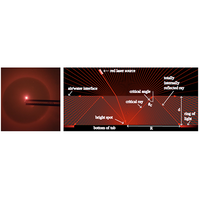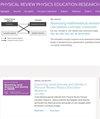Open-inquiry opens doors to intriguing optics experiments at home: A case study
IF 2.6
2区 教育学
Q1 EDUCATION & EDUCATIONAL RESEARCH
Physical Review Physics Education Research
Pub Date : 2024-02-20
DOI:10.1103/physrevphyseducres.20.010108
引用次数: 0
Abstract
[This paper is part of the Focused Collection on Instructional labs: Improving traditions and new directions.] This manuscript presents a case study of an introductory physics student who, during the remote learning conditions imposed during the COVID-19 pandemic, found inspiration within a new, open-inquiry, project-based, laboratory curriculum designed at Portland State University. The phenomenon investigated by the study subject was intriguing to both the student and the lab instructors for its unfamiliar and instructive optical effect: a ring-shaped pattern or halo created by a laser diffusely reflected in a shallow body of water. Drawing on classwork and interview responses, this study shows that the subject achieved many expected curriculum outcomes, particularly with respect to experimental design and data analysis tasks, indicating that the course’s open-inquiry structure can be effective while offering students a free choice of what to investigate in a laboratory class. Additionally, the case study shows that the halo phenomenon is pedagogically rich as it combines refraction, diffuse reflection, and total internal reflection in a nontrivial way, thereby answering calls by physics education researchers for more complex, realistic examples in geometric optics instruction. Finally, this case also highlights challenges students may experience interpreting diffuse reflection and determining the position of optical features beyond image formation, not commonly a focus of introductory physics courses, textbooks, and education research.

开放式探究为在家进行有趣的光学实验打开了大门:案例研究
[本文是 "教学实验重点文集 "的一部分:改进传统和新方向]。本手稿介绍了一个物理入门学生的案例研究,在 COVID-19 大流行期间,该学生在远程学习条件下,在波特兰州立大学设计的新的、开放式探究、基于项目的实验课程中找到了灵感。研究对象所研究的现象对学生和实验指导教师来说都很有趣,因为它既陌生又具有指导性的光学效果:激光在浅水中漫反射产生的环形图案或光环。通过课堂作业和访谈回答,本研究表明,该课题实现了许多预期的课程成果,特别是在实验设计和数据分析任务方面,这表明课程的开放式探究结构可以有效地为学生提供在实验课上自由选择探究内容的机会。此外,该案例研究还表明,光环现象具有丰富的教学内容,因为它以一种非简单的方式将折射、漫反射和全内反射结合在一起,从而响应了物理教育研究人员的呼吁,即在几何光学教学中提供更复杂、更真实的例子。最后,本案例还凸显了学生在解释漫反射和确定图像形成之外的光学特征位置时可能遇到的挑战,而这通常不是物理入门课程、教科书和教育研究的重点。
本文章由计算机程序翻译,如有差异,请以英文原文为准。
求助全文
约1分钟内获得全文
求助全文
来源期刊

Physical Review Physics Education Research
Social Sciences-Education
CiteScore
5.70
自引率
41.90%
发文量
84
审稿时长
32 weeks
期刊介绍:
PRPER covers all educational levels, from elementary through graduate education. All topics in experimental and theoretical physics education research are accepted, including, but not limited to:
Educational policy
Instructional strategies, and materials development
Research methodology
Epistemology, attitudes, and beliefs
Learning environment
Scientific reasoning and problem solving
Diversity and inclusion
Learning theory
Student participation
Faculty and teacher professional development
 求助内容:
求助内容: 应助结果提醒方式:
应助结果提醒方式:


